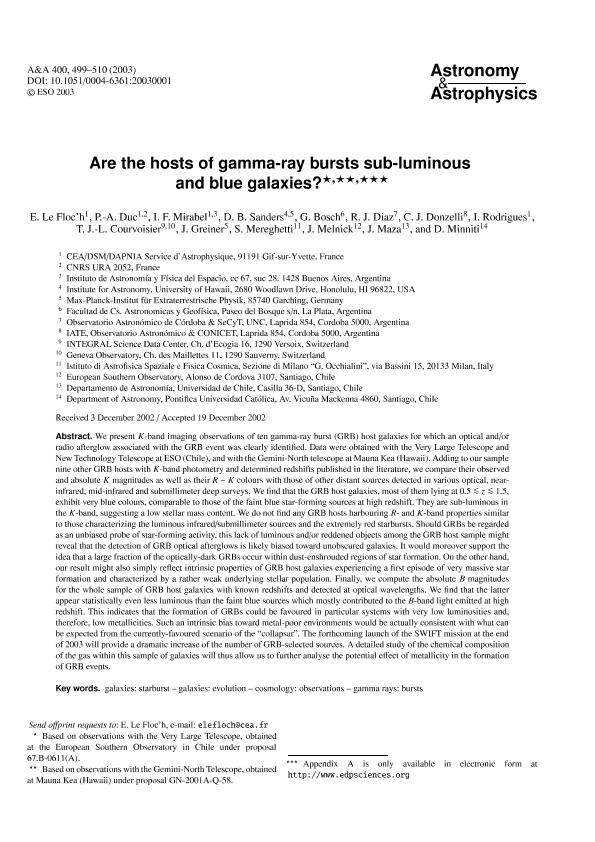Artículo
Are the hosts of gamma-ray bursts sub-luminous and blue galaxies?
Le Floch, E.; Duc, P.; Mirabel Miquele, Igor Felix ; Sanders, D.; Bosch, Guillermo Luis
; Sanders, D.; Bosch, Guillermo Luis ; Diaz, Ruben Joaquin
; Diaz, Ruben Joaquin ; Donzelli, Carlos Jose
; Donzelli, Carlos Jose ; Rodrigues, I.; Courvoisier, T.; Greiner, J.; Mereghetti, S.; Melnick, J.; Maza, J.; Minitti, D.
; Rodrigues, I.; Courvoisier, T.; Greiner, J.; Mereghetti, S.; Melnick, J.; Maza, J.; Minitti, D.
 ; Sanders, D.; Bosch, Guillermo Luis
; Sanders, D.; Bosch, Guillermo Luis ; Diaz, Ruben Joaquin
; Diaz, Ruben Joaquin ; Donzelli, Carlos Jose
; Donzelli, Carlos Jose ; Rodrigues, I.; Courvoisier, T.; Greiner, J.; Mereghetti, S.; Melnick, J.; Maza, J.; Minitti, D.
; Rodrigues, I.; Courvoisier, T.; Greiner, J.; Mereghetti, S.; Melnick, J.; Maza, J.; Minitti, D.
Fecha de publicación:
03/2003
Editorial:
EDP Sciences
Revista:
Astronomy and Astrophysics
ISSN:
0004-6361
Idioma:
Inglés
Tipo de recurso:
Artículo publicado
Clasificación temática:
Resumen
We present K-band imaging observations of ten gamma-ray burst (GRB) host galaxies for which an optical and/or radio afterglow associated with the GRB event was clearly identified. Data were obtained with the Very Large Telescope and New Technology Telescope at ESO (Chile), and with the Gemini-North telescope at Mauna Kea (Hawaii). Adding to our sample nine other GRB hosts with K-band photometry and determined redshifts published in the literature, we compare their observed and absolute K magnitudes as well as their R − K colours with those of other distant sources detected in various optical, nearinfrared, mid-infrared and submillimeter deep surveys. We find that the GRB host galaxies, most of them lying at 0.5 <∼ z <∼ 1.5, exhibit very blue colours, comparable to those of the faint blue star-forming sources at high redshift. They are sub-luminous in the K-band, suggesting a low stellar mass content. We do not find any GRB hosts harbouring R- and K-band properties similar to those characterizing the luminous infrared/submillimeter sources and the extremely red starbursts. Should GRBs be regarded as an unbiased probe of star-forming activity, this lack of luminous and/or reddened objects among the GRB host sample might reveal that the detection of GRB optical afterglows is likely biased toward unobscured galaxies. It would moreover support the idea that a large fraction of the optically-dark GRBs occur within dust-enshrouded regions of star formation. On the other hand, our result might also simply reflect intrinsic properties of GRB host galaxies experiencing a first episode of very massive star formation and characterized by a rather weak underlying stellar population. Finally, we compute the absolute B magnitudes for the whole sample of GRB host galaxies with known redshifts and detected at optical wavelengths. We find that the latter appear statistically even less luminous than the faint blue sources which mostly contributed to the B-band light emitted at high redshift. This indicates that the formation of GRBs could be favoured in particular systems with very low luminosities and, therefore, low metallicities. Such an intrinsic bias toward metal-poor environments would be actually consistent with what can be expected from the currently-favoured scenario of the “collapsar”. The forthcoming launch of the SWIFT mission at the end of 2003 will provide a dramatic increase of the number of GRB-selected sources. A detailed study of the chemical composition of the gas within this sample of galaxies will thus allow us to further analyse the potential effect of metallicity in the formation of GRB events.
Palabras clave:
Galaxies
,
Starbursts
,
Evolution of Galaxies
,
Cosmology
,
Gamma Ray Bursts
Archivos asociados
Licencia
Identificadores
Colecciones
Articulos(IALP)
Articulos de INST.DE ASTROFISICA LA PLATA
Articulos de INST.DE ASTROFISICA LA PLATA
Citación
Le Floch, E.; Duc, P.; Mirabel Miquele, Igor Felix; Sanders, D.; Bosch, Guillermo Luis; et al.; Are the hosts of gamma-ray bursts sub-luminous and blue galaxies?; EDP Sciences; Astronomy and Astrophysics; 400; 2; 3-2003; 499-510
Compartir
Altmétricas



